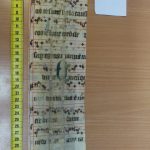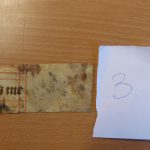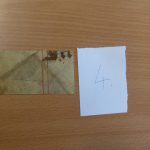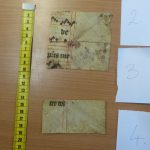The fragments hithherto unknown in the research were identified on 28 November 2019 in their repository in Szombathely, in the Vas County Archives of the Hungarian National Archives, with the kind participation of deputy director of the Archives, Péter Kóta. According to the thoughtful documentation attached to the host book and the separated fragment material, the fragments were restored in 2006 on behalf of the Vas County Archives.
We were able to reconstruct the position of the longer, thin parchment strip (number 1) and the three fragmentula (2–4) in the original manuscript, as well as the order of rectos and versos on the basis of the liturgical–musical content. All the fragments belonged to the same page: the introit Gaudete iusti in Domino, which begins at the bottom of recto_1 continues on the fragmentulum recto_4, while its end with the closing alleluia is legible on the verso with the barely recognizable closing alleluia on the top of verso_1. The further chants of the recto, the torsos of Signa eos and Quicumque fecerit were preserved on two fragments each: Signa eos can be reconstructed from recto_1 and recto_2, Quicumque from the lines of recto_1 and recto_3 (the uppermost staff of recto_3 with the melody-torso of Quicumque on it is legible at the bottom of recto_2). The chants of the verso can be assembled similarly: Dico vobis can be identified by putting together verso_1 and verso_2, Statuit ei, by placing verso_1 and verso_3 next to each other (the cut off S-initial of Statuit can be reconstructed by placing verso_2 and verso_3 exactly below). Verso_4 preserved the half-cut initial M of the introit Misericordias Domini, the continuation of which remained with the closing EUOUAE psalm differentia on the last line of verso_1.
A partially legible rubric in the middle of verso_1, which is presumably a fragment of the text De uno confessore et pontifice – an introduction to the common Mass of the confessor bishops – is of great help in the orientation. This is indeed followed by the usual introit Statuit ei Dominus. All this also means that the series of communions before the rubric belonged to another feast type of the commune sanctorum. Judging from the general liturgical assignation of the communions occurring here, this feast type was the commune plurimorum martyrum: every communion could be included in the common chants of martyrs.
From the succession of the chants of the fragment we can also deduce the editing process of the original codex and the inner order of the commune sanctorum: the chants of the common masses of the saints were probably grouped by “type” of saints, and within by genre. This procedure was quite common in the Hungarian late medieval sources: the Spiš Graduale (Knižnica Spišskej Kapituly Mss. No. 1, f. 167r–169r, online: http://cantus.sk/source/6778) was edited and arranged in the same way, or the commune set of the fragmentary “Esztergom” Graduale (see the fragments F 722, 900, 901, 902 in our database, and the fragment F 225 of the Szendrei catalogue preserved as the cover of OSzK Inc. 387).
The thinned stems in the notation suggest Northern (and indirect Bohemian) impact, which is confirmed by the square custos, a typical element of the Bohemian notation. The turning and squaring of the rhomboid puncta is striking. Alongside the square custos, this notation lacks the Hungarian elements. One of the notations of our sources, it is quite close to the first notation of a Pozsony/Bratislava Antiphoner (Antiphonale Strigoniense „Knauz 4”, Bratislava, Slovenský národný archív 4, online: http://cantus.sk/source/3192 – Antiphonary of Bratislava IIb). It is quite possible that the origin of the antiphoner and mother codex of our fragment can be traced back to the same school or scribal workshop in 15th-century Bratislava.
Zsuzsa Czagány
Gabriella Gilányi










